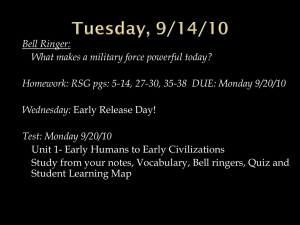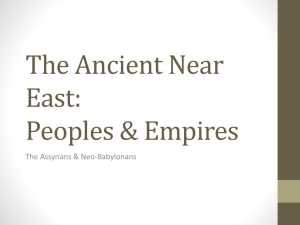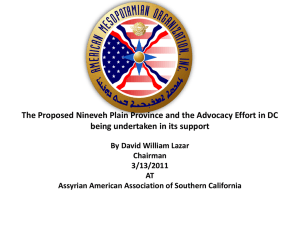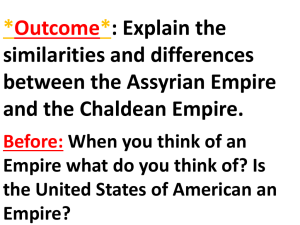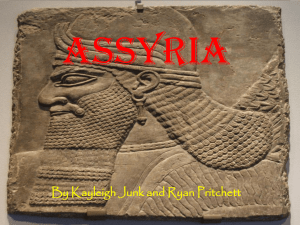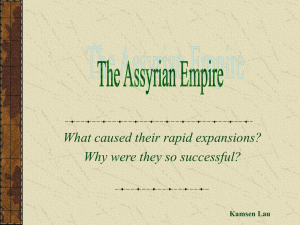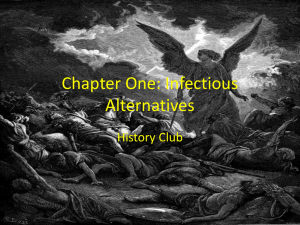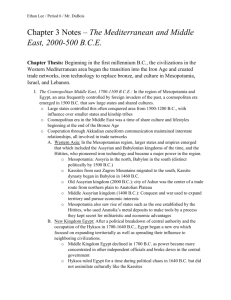Printer Friendly Syllabus
advertisement
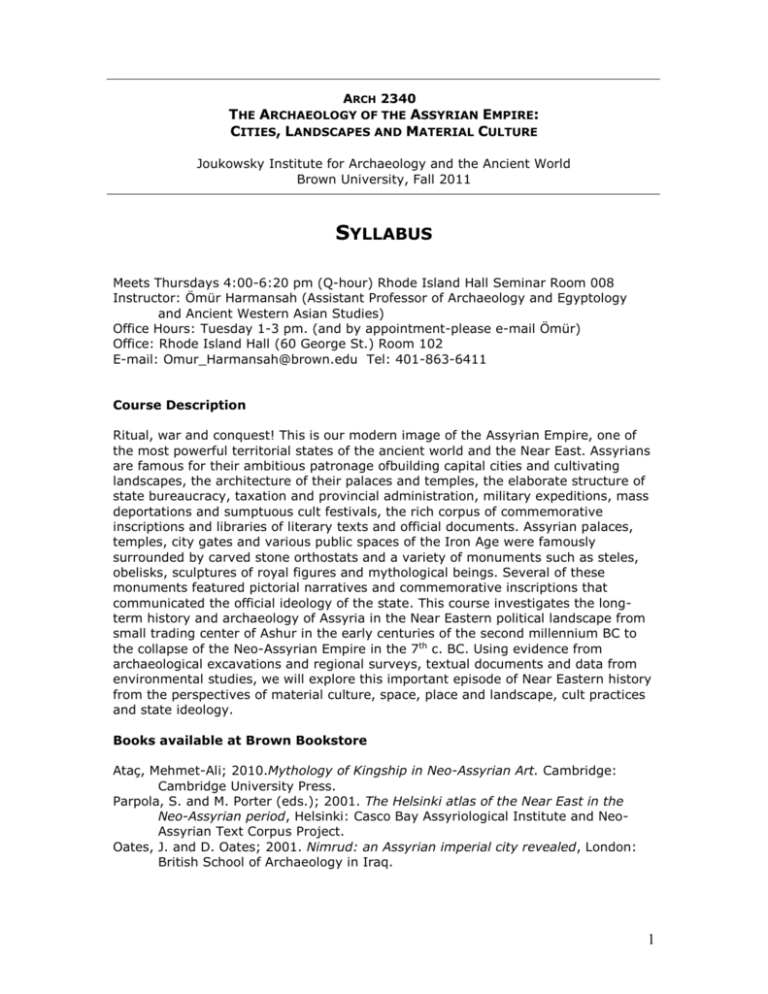
ARCH 2340 THE ARCHAEOLOGY OF THE ASSYRIAN EMPIRE: CITIES, LANDSCAPES AND MATERIAL CULTURE Joukowsky Institute for Archaeology and the Ancient World Brown University, Fall 2011 SYLLABUS Meets Thursdays 4:00-6:20 pm (Q-hour) Rhode Island Hall Seminar Room 008 Instructor: Ömür Harmansah (Assistant Professor of Archaeology and Egyptology and Ancient Western Asian Studies) Office Hours: Tuesday 1-3 pm. (and by appointment-please e-mail Ömür) Office: Rhode Island Hall (60 George St.) Room 102 E-mail: Omur_Harmansah@brown.edu Tel: 401-863-6411 Course Description Ritual, war and conquest! This is our modern image of the Assyrian Empire, one of the most powerful territorial states of the ancient world and the Near East. Assyrians are famous for their ambitious patronage ofbuilding capital cities and cultivating landscapes, the architecture of their palaces and temples, the elaborate structure of state bureaucracy, taxation and provincial administration, military expeditions, mass deportations and sumptuous cult festivals, the rich corpus of commemorative inscriptions and libraries of literary texts and official documents. Assyrian palaces, temples, city gates and various public spaces of the Iron Age were famously surrounded by carved stone orthostats and a variety of monuments such as steles, obelisks, sculptures of royal figures and mythological beings. Several of these monuments featured pictorial narratives and commemorative inscriptions that communicated the official ideology of the state. This course investigates the longterm history and archaeology of Assyria in the Near Eastern political landscape from small trading center of Ashur in the early centuries of the second millennium BC to the collapse of the Neo-Assyrian Empire in the 7th c. BC. Using evidence from archaeological excavations and regional surveys, textual documents and data from environmental studies, we will explore this important episode of Near Eastern history from the perspectives of material culture, space, place and landscape, cult practices and state ideology. Books available at Brown Bookstore Ataç, Mehmet-Ali; 2010.Mythology of Kingship in Neo-Assyrian Art. Cambridge: Cambridge University Press. Parpola, S. and M. Porter (eds.); 2001. The Helsinki atlas of the Near East in the Neo-Assyrian period, Helsinki: Casco Bay Assyriological Institute and NeoAssyrian Text Corpus Project. Oates, J. and D. Oates; 2001. Nimrud: an Assyrian imperial city revealed, London: British School of Archaeology in Iraq. 1 Course wiki A wiki is created for this course and we will use this site actively throughout the semester. Weekly reading materials, lecture images, announcements, assignments and discussions will be posted on the wiki. Students registered or auditing the course will have access to editing the pages of the course wiki which facilitates collaborative work. At the end of the semester, our accumulated work within the frame of this seminar will be archived in the wiki. Please familiarize yourself with the page, and make sure to check the site regularly, at least a few times every week. http://proteus.brown.edu/assyrianempire11 Readings and reserves All readings will be posted on the course wiki in pdf format. Some books with images and maps that need to be shared will be on reserve in the Joukowsky Institute library (2nd floor corridor). A specific shelf will be dedicated to our class readings. Please us the book at the Institute and leave a note with your e-mail address if you have to remove it from the building for any extended period of time. Course Requirements Students are expected to do weekly readings comprehensively, and contribute to seminar discussions as much as possible. A graduate seminar is only successful if all participants collaborate effectively with critical debate and collegial responsibility. Students will be occasionally asked to volunteer for short presentations in class on selected articles, sites or a specific body of archaeological/textual material (2-3 presentations per student depending on class size). In the first half of the semester, the written tasks will involve a series of brief response papers(5 in total) in relation to our discussions during the seminars (due in class in week 3,4,5,6 and7: see weekly schedule). In the second half, students will focus on their research project. There will be no exams. Grading will be based on class participation (20%), oral presentations (20%), response papers (20%), research project (40%). Class participation includes regular attandance and contribution to seminar discussions. Research project Students will choose a research topic in collaboration with the professor and turn it into a project. The project should involve an analytical and critical discussion of a relevant historical problem or topic, relevant to our seminar discussions (drawing comparisons from outside Assyria are always welcome). The research project’s presentations will include a 15-20 min class presentation of the project, a 6-8 page draft (to be submitted on the day of the presentation) and a 14-20 page final paper (double spaced). 2 Weekly Schedule Week 1. September 8 Introduction: overview of the seminar. Week 2. September 15 Travelers, antiquarians and Assyrians: Roots of modernity, colonialism and orientalism in Assyria. Diaz-Andreu, Margarita; 2007. “Biblical archaeology,” in A World History of Nineteenth-Century Archaeology: Nationalism, Colonialism, and the Past. Oxford University Press, 131-166. Bohrer, Frederick N.; 1998. “Inventing Assyria: Exoticism and Reception in Nineteenth-Century England and France,” Art Bulletin 80: 336-356. Holloway, Steven W.; 2004. “Nineveh Sails for the New World: Assyria Envisioned by Nineteenth-Century America” Iraq 66: 243-256. Holloway, Steven W.; 2006. "Introduction: Orientalism, Assyriology and the Bible” In Orientalism, Assyriology and the Bible. S.W.Holloway (ed). Sheffield Phoenix Press, 1-41. Frahm, Eckart; 2006. “Images of Assyria in Nineteenth- and Twentieth-century western scholarship. ”In Orientalism, Assyriology and the Bible. S.W.Holloway (ed). Sheffield Phoenix Press, 74-94. Cohen, Ada and Steven E. Kangas; 2010. “Our Nineveh Enterprise,” in Assyrian reliefs from the palace of Ashurnasirpal II: a cultural biography. A. Cohen and S.E. Kangas (eds.). Hanover: Hood Museum of Art and University Press of New England, 1-47. Larsen, Morgens Trolle; 1996.The conquest of Assyria: excavations in an antique land 1840-1860. London and New York: Routledge. Skim through and read sections. Week 3. September 22 Family business in Anatolia: The city-state of Ashur and Assyrian trading colonies. The archaeology of early Ashur. Presentation Site: Kültepe, Text: Royal Inscription of Shamshi-Adad, king of Ekallatum, Ashur’s limmu (eponym official) stelae and its significance for Assyrian chronologies. Response Paper 1 Due Kuhrt, Amélie; 1995. The Ancient Near East: c. 3000-330 B.C. 2 Vols. Routledge: London and New York, 348-365. Chalavas, Mark (ed.); 2006.The ancient Near East: historical sources in translation. Malden MA: Blackwell, 102-104. Assyrian colonies in Anatolia Berdan, Frances F.; 1989.“Trade and markets in precapitalist states,” in Economic anthropology.Stuart Plattner (ed). Stanford University Press, 78-107. Veenhof, Klaas R. and Jesper Eidem; 2008. Mesopotamia: The Old Assyrian Period. Academic Press Fribourg. Read 147-182. Kuhrt, Amélie; 1998.“The Old Assyrian merchants,” in Trade, traders and the ancient city. H. Parkins& C. Smith (eds.), Routledge: London, 1-15. 3 Barjamovic, Gojko; 2008.“The Geography of Trade – Assyrian Colonies in Anatolia c. 1975 – 1725 B.C. and the Study of Early Interregional Networks of Exchange” In Anatolia and the Jazira during the Old Assyrian Period. J.G. Dercksen (ed.) (PIHANS 111), Leiden:Nederlands Instituut voor het Nabije Osten, 87-100. Bajramovic, Gojko; 2010.A Historical Geography of Anatolia in the Old Assyrian Colony Period.(Carsten NiebuhrInstitute Publications 38). Copenhagen: Museum Tusculanum Press. (Good Maps) The city of Ashur Feldman, Marian H.; 2006. “Assur Tomb 45 and the Birth of the Assyrian Empire,” Bulletin of the American Schools of Oriental Research 343: 21-43. Altaweel, M.; 2008 The imperial landscape of Ashur: settlement and land use in the Assyrian heartland (Heidelberger Studien zum Alten Orient 11), Heidelberg: Heidelberger Orientverlag. Harper, Prudence O et. al.; 1995. Discoveries at Ashur on the Tigris: Assyrian origins. Antiquities in the Vorderasiatisches Museum, Berlin. New York: The Metropolitan Museum of Art. Week 4. September 29. From Bronze to Iron: The archaeology of the Middle Assyrian Period. Presentation Site: Tell SabiAbyad, DurKatlimmu. Topic: Mitanni-Middle Assyrian continuity in Upper Mesopotamian landscapes: dunnu-dimtu settlements. Response Paper 2 Due. Postgate, J.N.; 1992.“The Land of Assur and the Yoke of Assur.” World Archaeology 23: 247-263. Postgate, J. Nicholas; 1997c. “Middle Assyrian to Neo-Assyrian: the nature of the shift,” in Assyrien im Wandel der Zeiten: XXXIXe Rencontre Assyriologique Internationale Heidelberg 6.-10. Juli 1992.H. Waetzoldt& H. Hauptmann (eds.); Heidelberg: Heidelberger Orientverlag, 159-168. Neumann, J. & Simo Parpola; 1987.“Climatic change and the 11 th-10th c. eclipse of Assyria and Babylonia,” JNES 46: 161-182. Lyon, Jerry D.; 2000. “Middle Assyrian expansion and settlement development in the Syrian Jazira: the view from the Balikh valley.” In Rainfall and agriculture in Northern Mesopotamia. R.M. Jas (ed.), Proceedings of the Third Mos Symposium, Leiden 1999; Istanbul: Nederlands Historisch-Archaeologisch Instituut, 89-126. Dur Katlimmu Kühne, Hartmut; 2000. “Dūr-katlimmu and the Middle-Assyrian empire,” in La Djéziré et l’Euphrate Syriens de la Protohistoire à la fin du IIe Millénaire av. J.-C. Tendances dans l’interprétation historique des données nouvelles (Subartu VII). Olivier Rouault and Markus Wäfler (eds.), Brepols: 271-277. Tell Sabi Abyad Akkermans, Peter M.M.G; José Limpens; Richard H. Spoor; 1993. “On the frontier of Assyria: excavations at Tell Sabi Abyad, 1991,” Akkadica 84-85: 1-52. Duistermaat, Kim; 2008. The pots and potters of Assyria: Technology and organization of production, ceramic sequence and vessel function at Late Bronze Age Tell Sabi Abyad. Turnhout : Brepols. Wiggermann, Frans A.M.; 2000. “Agriculture in the Northern Balikh Valley: The case of Middle Assyrian Tell Sabi Abyad,” ,” in Rainfall and agriculture in Northern Mesopotamia. R.M. Jas (ed.), Proceedings of the Third Mos Symposium, Leiden 1999; Istanbul: Nederlands Historisch-Archaeologisch Instituut, 171-231. 4 Week 5. October 6 The city of Nimrud and Aššurnasirpal II: ideology of the empire, narratives of state. Critical review of art historical studies of Assyrian palace reliefs. Response Paper 3 Due. Ideology and sovereignty Eagleton, Terry; 1991.“Introduction” Ideology: an introduction. London:Verso, 1-40. Smith, Adam; 2011. “Archaeologies of sovereignty,” Annual Review of Anthropology 40: 415-32. Liverani, Mario; 1979."The Ideology of the Assyrian Empire" inPower and Propaganda: A Symposium on Ancient Empires. M.T. Larsen (ed.). Copenhagen: 297-317. Nimrud Oates, J. and D. Oates; 2001. Nimrud: an Assyrian imperial city revealed, London: British School of Archaeology in Iraq. Study of Assyrian reliefs Winter, Irene J.; 1981."Royal Rhetoric and the Development of Historical narrative in Neo-Assyrian Reliefs", Studies in Visual Communication 7: 2-38. Pittman, Holly; “The White Obelisk and the problem of historical narrative in the art of Assyria,” Art Bulletin 78 (1996) 334-355. Russell, John Malcolm; 1998.“The program of the palace of Assurnasirpal II at Nimrud: Issues in the research and presentation of Assyrian art,” AJA 102: 655715. Reade, Julian E.; "Ideology and Propaganda in Assyrian Art." In Power and Propaganda: A Symposium on Ancient Empires . M.T. Larsen (ed.), Copenhagen, 1979: 329-359. Week 6. October 13 When texts are not just texts: Assyrian Royal Inscriptions: symbolisms of power, mythologies of kingship and the royal rhetoric. Guest: Prof. Matthew Rutz. Text: Banquet Stele, Balawat Gate Bronzes. Response Paper 4 Due. Kingship Ataç, Mehmet-Ali; 2010. Mythology of Kingship in Neo-Assyrian Art. Cambridge: Cambridge University Press. Excerpts Westenholz, Joan Goodnick; 2000. “The king, the emperor, and the empire: continuity and discontinuity of royal representation in text and image,” in The heirs of Assyria: Proceedings of the opening symposium of the Assyrian and Babylonian intellectual heritage project. S. Aro& R.M. Whiting (eds.); The NeoAssyrian Text Corpus Project, Melammu Symposia I; Helsinki: 99-125. Assyrian Royal Inscriptions Tadmor, Hayim; 1981. “History and ideology in the Assyrian royal inscriptions,” in Assyrian royal inscriptions: New horizons in literary, ideological and historical analysis. F.M. Fales (ed.), Roma: Istituto per l’Oriente, Centro per le Antichità e la Storia dell’Arte del Vicino Oriente, 13-33. Tadmor, Hayim; 1997. “Propaganda, literature, historiography: Cracking the code of the Assyrian royal inscriptions,” in Assyria 1995. Proceedings of the 10 th Anniversary Symposium of the Neo-Assyrian Text Corpus 5 Project.SimoParpola&R.M. Whiting (eds.). Helsinki: The Neo-Assyrian Text Corpus Project, 325-338. Grayson, A. Kirk; 1996. Assyrian rulers of the Early First Millennium B.C. II (858-745 B.C.). RIMA 3. University of Toronto Press, Toronto. Week 7 October 20 Empire, frontiers and landscape: the Jazira and the Upper Tigris Region – a case of agricultural colonization? Text: Kurkh Monument Response Paper 5 Due. Smith, Adam T.; 2003. The political landscape: constellations of authority in early complex polities. Berkeley: University of California Press. Excerpts. Jazira Wilkinson, Tony J.; Jason Ur, Eleanor Barbanes Wilkinson, Mark Altaweel; 2005. “Landscape and settlement in the Neo-Assyrian Empire,” Bulletin of the American Schools of Oriental Research 340: 23-56. Wilkinson, Tony J.; 1995."Late-Assyrian Settlement Geography in Upper Mesopotamia" in Neo-Assyrian Geography. Mario Liverani (ed.); Università di Roma “La Sapienza,” Dipartimento di Scienzestoriche, archeologiche e anthropologichedell’Antichità, Quaderni di GeografiaStorica 5: Roma: Sargon srl, 139-159. Morandi Bonacossi, Daniele; 1996.“Landscapes of power: the political organisation of space in the Lower Habur valley in the Neo-Assyrian period,” SAAB 10.2: 15-49. Upper Tigris Basin Radner, Karin and Andreas Schachner; 2001. “From Tušhan to Amēdi: topographical questions concernin the Upper Tigris region in the Assyrian period,” in Salvage Project of the Archaeological Heritage of the Ilısu and Carchemish dam reservoirs: activities in 1999. N. Tunaet. al. (eds.); Ankara: Middle East Technical University, Centre for Research and Assessment of the Historic Environment, 749-776. Parker, Bradley J.; 2002. “At the edge of the empire: conceptualizing Assyria’s Anatolian frontier ca 700 BC,” Journal of Anthropological Archaeology 21: 371395. MacGinnis, John and Timothy Matney; 2009. “Archaeology at Frontiers: Excavating a Provincial Capital of the Assyrian Empire.” Journal of Assyrian Academic Studies 23: 3-21. Week 8 October 27 Religion and the exercise of power: the Assyrian urban festivals and cult places. Holloway, Steven W.; 1995. “Harran: Cultic geography in the Neo-Assyrian empire and its implications for Sennacherib’s ‘Letter to Hezekiah’ in 2 Kings,” in The pitcher is broken: Memorial essays for Gösta W. Ahlström, S. V. Holloway & L.K. Handy (eds.), Journal for the Study of the Old Tastement Suppl. Series 190, Sheffield: 276-314. Holloway, Steven W.; 2002. Aššur is king! Aššur is king! Religion in the exercise of power in the Neo-Assyrian empire. Brill: Leiden. Nakamura, Carolyn; 2004. “Dedicating magic: Neo-Assyrian apotropaic figurines and the protection of Assur,” World Archaeology 36: 11-25. Akitu festival 6 Pongratz-Leisten, Beate; 1997. “The interplay of military strategy and cultic practice in Assyrian politics,” in Assyria 1995. Proceedings of the 10th Anniversary Symposium of the Neo-Assyrian Text Corpus Project. Simo Parpola & R.M. Whiting (eds.). Helsinki: The Neo-Assyrian Text Corpus Project, 245-252. Bidmead, Julye; 2002. The akītu festival: religious continuity and royal legitimation in Mesopotamia. Gorgias Dissertations Near Eastern Studies 2. Piscataway, New Jersey: Gorgias Press. Week 9 November 3 Memory, time and the geological landscapes of ritual and politics: Assyrian rock reliefs and other royal monuments on the periphery. Sites: Source of the Tigris, Nahr el-Kalb, Karabur. Volk, Lucia; 2008."When memory repeats itself: The politics of heritage in post civil war Lebanon," International Journal of Middle East Studies 40: 291-314. Shafer, Ann Taylor; 2007. “Assyrian royal monuments on the periphery: ritual and the making of imperial space” Ancient Near Eastern Art in Context: Studies in Honor of Irene J. Winter by her students. Jack Cheng and Marian H. Feldman(eds.). Leiden: Brill Publishers, 133-160. Harmanşah, Ömür; 2007. “Source of the Tigris: event, place and performance in the Assyrian landscapes of the Early Iron Age,” Archaeological Dialogues 14.2 (December): 179-204. Schachner, Andreas, 2006. “An den Ursprung des Tigris schriebich meinen Namen – Archäologische Forschungen am Tigris-Tunnel.” Antike Welt 37: 77–83. Taşyürek, O. Aytuğ; 1975. “Some New Assyrian Rock Reliefs in Turkey,” Anatolian Studies 25: 169-180. Taşyürek, O. Aytuğ; 1979.“A Rock Relief of Shalmaneser III on the Euphrates.”Iraq41: 47-53. Ma"ila-Afeiche, Anne-Marie (ed.); 2009. Le Site de Nahr el-Kalb. BAAL Bulletin d'Archeologie et d' Architecture Libanaises Hors Serie V. Kreppner, Florian Janoscha, 2002, "Public Space in Nature: The Case of Neo-Assyrian Rock Reliefs." Altorientalisch Feorschungen29: 367-83. Week 10 November 10. Sargon and Dur-Sharrukin: city building as a metaphor for Empire. Joffe, Alexander H.; 1998. “Disembedded capitals in Western Asian perspective,” Comparative Studies in Society and History 40: 549-580. Van de Mieroop, Marc; 1999a. “Literature and political discourse in Ancient Mesopotamia: Sargon II of Assyria and Sargon of Agade,” in Munuscula Mesopotamica: Festschrift für Johannes Renger, B. Böck, E. Cancik-Kirschbaum, T. Richter (eds.), Ugarit Verlag, Münster: 327-339. Albenda, Pauline; 1986.The palace of Sargon, king of Assyria: monumental wall reliefs at Dur-Sharrukin, from original drawings made at the time of their discovery in 1843-1844 by Botta and Flandin. Paris: Editions Recherche sur les Civilisations. Caubet, Annie (ed.); 1995. Khorsabad, le palais de Sargon II, roid’Assyrie.Actes du colloque organisé au musée de Louvre par le Service culturel les 21 et 22 janvier 1994. Paris: La documentation Français. Week 11 November 17. Nineveh and the social production of urban space.Sennacherib’s new quarries. 7 Lefebvre, Henri; 1991. The production of space.D.Nicholson-Smith (trans.), Balckwell: Oxford. Originally published as Production de l’espace, Editions Anthropos 1974. Excerpts. Lumsden, Stephen; 2005. "The production of space at Nineveh," in Nineveh: Papers of the XLIXe Rencontre Assyriologique Internationale, London 7—11 July 2003. D. Collon and A. George (eds). London: British School of Archaeology in Iraq, 187197. Stronach, David; 1995.“Notes on the topography of Nineveh,” in Neo-Assyrian geography.Mario Liverani (ed.); Università di Roma “La Sapienza,” Quaderni di GeografiaStorica 5: Roma: Sargon srl, 161-170. Russell, John Malcolm; 1987. “Bulls for the palace and order in the empire: The sculptural program of Sennacherib’ Court VI at Nineveh,” Art Bulletin 69: 520-539. November 25 No Class- Thanksgiving. Week 12 December 1. Violence and the state, violence as spectacles of the state: Lion hunts, bodily violence and the performance of empire. Assurbanipal and the palace relief program at Nineveh. Foucault, Michel; 2006. "Governmentality" in Anthropology of the state: a reader. Akhil Gupta (ed.). Malden MA: Blackwell, 131-143. Bahrani, Zainab; 2008. Rituals of war: the Body and Violence in Mesopotamia. Zone Books: The MIT Press. Na’aman, Nadav; 1991. “Forced participation in alliances in the course of the Assyrian campaigns to the West,” in Ah Assyria... Studies in Assyrian history and Ancient Near Eastern historiography presented to Hayim Tadmor. M. Cogan and I. Eph’al (eds.); Scripta Hierosolymitana 33. Jerusalem: The Magnes Press, The Hebrew University, 80-98. Stronach, David; 1997.“Notes on the fall of Nineveh,” in Assyria 1995.Proceedings of the 10th Anniversary Symposium of the Neo-Assyrian Text Corpus Project. Simo Parpola & R.M. Whiting (eds.). Helsinki: The Neo-Assyrian Text Corpus Project, 307-324. Weissert, Elnathan; 1997b. “Royal hunt and royal triumph in a prism fragment of Ashurbanipal (82-5-22,2),” in Assyria 1995. Proceedings of the 10th Anniversary Symposium of the Neo-Assyrian Text Corpus Project. Simo Parpola&R.M. Whiting (eds.). Helsinki: The Neo-Assyrian Text Corpus Project, 339-358. Aker, Jülide; 2007. “Workmanship as ideological tool in the monumental hunt reliefs of Assurbanipal” In Ancient Near Eastern Art in Context: Studies in Honor of Irene J. Winter by her students. Jack Cheng and Marian H. Feldman(eds.). Leiden: Brill Publishers, 229-264. Week 13 December 8. Class Presentations of Research Projects December 20. Final deadline for papers. 8
